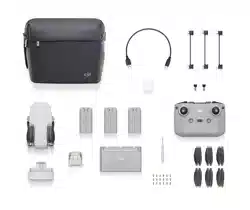Loading ...
Loading ...
Loading ...

©
2020 DJI All Rights Reserved.
17
DJI Mini 2 User Manual
Using the Vision Systems
When GPS is unavailable, the Downward Vision System is enabled if the surface has a clear texture and
there is sucient light. The Downward Vision System works best when the aircraft is at an altitude of 0.5
to 10 m. If the altitude of the aircraft is above 10 m, the Vision System may be aected. Extra caution is
required.
Follow the steps below to use the Downward Vision System.
1. Make sure the aircraft is in Normal or Cine mode. Power on the aircraft.
2. The aircraft hovers in place after takeo. The aircraft status indicator blinks green twice, indicating
the Downward Vision System is working.
Pay attention to the ight environment. The Downward Vision System and Infrared Sensing System
only work under limited conditions and cannot replace human control and judgment. During
ight, always pay attention to the surrounding environment and to the warnings on DJI Fly and be
responsible for and maintain control of the aircraft.
The aircraft has a max hovering altitude of 5 m if GPS is available.
The Downward Vision System may not function properly when the aircraft is ying over water.
Therefore, the aircraft may not be able to actively avoid water below when landing. It is recommended
to maintain ight control at all times, make reasonable judgments based on the surrounding
environment, and avoid relying on the Downward Vision System.
Note that the Downward Vision System and Infrared Sensing System may not function properly when
the aircraft is ying too fast. The Infrared Sensing System only takes eect when the ight speed is no
more than 12 m/s.
The Downward Vision System cannot work properly over surfaces that do not have clear pattern
variations or there is weak light. The Downward Vision System cannot work properly in any of the
following situations. Operate the aircraft cautiously.
a) Flying over monochrome surfaces (e.g., pure black, pure white, pure green).
b) Flying over highly reective surfaces.
c) Flying over water or transparent surfaces.
d) Flying over moving surfaces or objects.
e) Flying in an area where the lighting changes frequently or drastically.
f) Flying over extremely dark (< 10 lux) or bright (> 40,000 lux) surfaces.
g) Flying over surfaces that strongly reect or absorb infrared waves (e.g., mirrors).
h) Flying over surfaces without clear patterns or texture. (e.g., power pole).
i) Flying over surfaces with repeating identical patterns or textures (e.g., tiles with the same design).
j) Flying over obstacles with small surface areas (e.g., tree branches).
Loading ...
Loading ...
Loading ...
